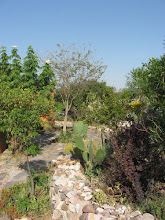*Citation: Frog, Kermit the, 1969.
When considering undertaking a Green Lifestyle, it behooves one to remember Kermit's lament. Although there are numerous rewards in Being---that is, "living"---Green, it takes more than just a casual commitment. Green is a way of life that requires conscious, not casual awareness.
Many of the environmental problems over the past decades have been caused by two important issues. One is the heavy reliance on petroleum products, gas, oil, plastics. The other is the reliance and ignorance of how one obtains the "basic" necessities, such as water, electricity and disposal of wastes. These two create a culture that doesn't understand and doesn't want to think about the wheres and hows of ordinary living.
When one makes a commitment to live Green, these basics of ordinary living come more sharply into focus. The next few posts will offer a few examples of basic living practices as practiced at Casita dos Arbolitos, a Homesite in San Jose de Gracia:
1. Water. Casita dos Arbolitos (CDA)has a total of 1850 Gallons (70,000 liters) of water-capturing/water-storage capacity , in two concrete Cisterns. This is the average amount of water, per homesite; with both smaller (approximately 30,000 liters) and larger (approximately 109,000 liters) in other sites. The rains come, the water flows into the Cisterns to be used as need. When the rains come, monitoring the Cisterns allows for distribution. The smaller cistern fills quickly and then extra water is pumped into tanks or back into the larger cistern. During the dry months, monitoring informs whether the amount of water captured will serve the needs of the homesite until the rainy season.
Water is used directly for washing bodies, clothes, dishes and for watering edible plants. "Gray water," from washing, is distributed directly, by hose, to trees and bushes; and by bucket to other plants and smaller trees not accessible by hose. Because of the human waste disposal method at CDA (more on that in a future Post), there is no creation of "black water," or the extra measures that are required in its handling. All water is used, then reused, and kept on the land.
Another, important water-management issue is Keeping rain water from eroding the land and washing the soil away. To mitigate erosion and to keep both the soil on the land and to help keep the water from rushing away without serving the property, the area around Casita Dos Arbolitos has had several types of simple barriers set up to slow water down and let it sink into the ground. Swales, a series of relatively deep (2 feet) ditches were dug across the open areas of the property; rainwater, as it begins to move downward on the property, falls into the swales. Berms, made either with rocks or mounds of earth, also slow the water as it flows downward. And a third method, free-standing rock terraces, capture both water and soil so that, y the time the rainwater reaches the arroyo at the bottom of the property, it is traveling slowly and without having taken away the basics structure of the land.
For more about Casita Dos Arbolitos and Mexico, visit the CDA Blog: https://sites.google.com/site/casitadosarbolitos/SMA/journal-blog
Subscribe to:
Post Comments (Atom)

No comments:
Post a Comment